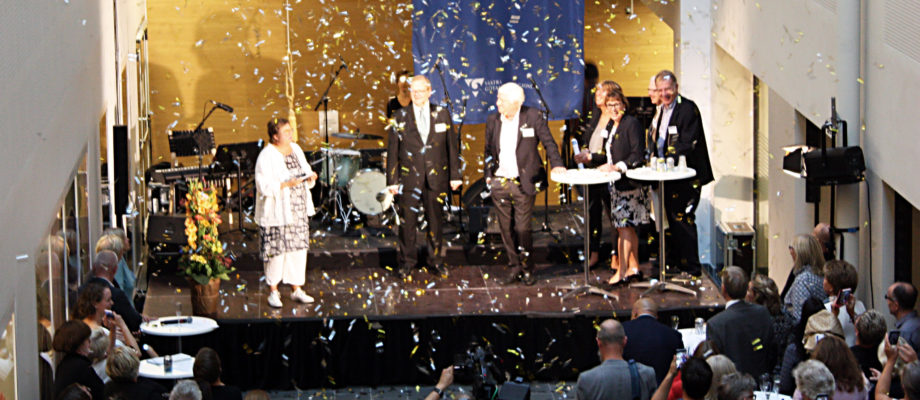From “a building strong enough to bear the weight of an MRI scanner,” to a vision of what Sahlgrenska University Hospital (SU) might do for patients in the future. That’s how some have described the journey from the initial plans 15 years ago to the inauguration of the Image and Intervention Center on September 23, 2016.
Music performed by students from the local Billströmska folk high school mixes with the voices of mingling guests to fill the more than 20-meter-high atrium sitting between the Image and Intervention Center and the corridor that runs through the heart of Sahlgrenska University Hospital’s main building. The guests begin to gather on the ground floor, and the balconies on all five upper floors fill with staff from the units that have already moved in. In the corridor, curious patients and visitors to the hospital stop in their tracks. There’s a party in progress—the grand opening of the new Image and Intervention Center.
President of Västra Götaland’s Regional Executive Board, Johnny Magnusson, begins by describing the overwhelming political unity behind the decision to approve funding for the Image and Intervention Center ten years ago.
“Sahlgrenska University Hospital should be leading the field when it comes to high-tech equipment. We want patients in Region Västra Götaland to have access to the best care available. It’s also important that staff at the region’s healthcare facilities and at SU see that we’re committed to improvements,” says Magnusson, and adds that he has already begun considering what the next investment should be to insure that the hospital maintains its leading status into the future.
Västra Götaland’s Regional Director Ann-Sofi Lodin further emphasizes the significance of the Image and Intervention Center for the region. The equipment not only supports narrow specializations, Lodin stresses, but will also benefit broad groups of patients, including stroke patients.
“Patients will receive faster, safer, and better care. This will not only save lives, it will also help make life after illness as enjoyable as possible,” she says.

Lodin thanks the project’s healthcare collaborators as well as Chalmers University of Technology and Sahlgrenska Academy, and makes special mention of two prime movers behind the project, Lennart Ring and Robert Leth: “Without you it might never have happened,” she says.
Ring and Leth, who served as project managers during the years-long construction phase, recall how it all began. As far back as 2003 there was a need—and also plans for—a new type of operating theater. Shortly after that time, Ring was contacted by the then-head of the hospital’s Radiology Department, Anne Olmarker:
“She needed MRI scanners located close to patients. ‘We can arrange that,’ I thought to myself. But it wasn’t possible with our existing buildings; they didn’t have the load-bearing capacity needed,” Ring recounts.
A makeshift facility was built on Level 2 of the hospital’s main building instead, and came to be known as the “MRI Bubble.” Ultimately, this structural engineering dilemma gave rise to plans for a new building.
“I presented the drawings to the executive body in 2005, and they rejected them outright. I must admit that it made me angry,” Ring explains.
Still, the project wasn’t dead in the water, it just needed a new focus, or what’s nowadays is called pivoting, explains Leth: “This time around it wasn’t about constructing a building, but about realizing the dream of what we wanted to offer stroke, cancer, and heart disease patients in 15 years’ time. A lot of people sat down in diverse groups to brainstorm and we spied on others, too—even internationally. The result was a vision of what we could potentially offer to citizens, but also to our partners in the private sector and academia. So, it’s not a building with the right load-bearing capacity we’ve built, but the infrastructure needed to realize that dream.”
Both Ring and Leth stress that the project succeeded in achieving a fluid goal—a crucial factor in securing the very latest medical technology and expertise—because its vision remained wholly unchanged throughout its duration.
Now, part of the Image and Intervention Center project stands complete and has been handed over to hospital management.
Hospital Director Ann-Marie Wennberg is both pleased and honored to be present and help open the center:
“Thanks to the Image and Intervention Center, SU and Region Västra Götaland now have one of the best centers for the diagnosis and treatment of cancer and neurological and cardiovascular diseases. We’ve brought together ultra-modern equipment and the very best expertise, putting us squarely at the forefront internationally,” she says.
Wennberg points out that the excellent, well-designed care and treatment facilities create opportunities for new and fruitful collaborations across specializations, which is unique from an international perspective.
“We’ll also attract greater interest on the research, development, and education fronts, which will benefit both patients and the close cooperation that exists between the hospital and Sahlgrenska Academy.”
Event moderator Anette Åquist Falkenrot, who ordinarily serves as the hospital’s chief medical information officer, further highlights the center’s expertise, and spontaneously invites the crowd to join her in a round of applause for the many staff who are standing in the balconies.
“SU is not just Gothenburg’s and the region’s hospital, but a hospital for the whole of Sweden. We shouldn’t forget that SU has been assigned the most national specialized medical care commissions of any institution in the country,” says Johnny Bröndt, Chairman of the Hospital’s Board of Directors, before he and Johnny Magnusson get on with the actual inauguration.
Accompanied by a drum-roll and cheers from the crowd, the two executives pull down on a golden tassel to unfurl from the atrium’s roof a 20-meter-long rainbow banner that reads “World-class expertise and technology.”
Once gold and silver confetti finishes raining down on the crowd, it feels as though the Image and Intervention Center is now truly open.











